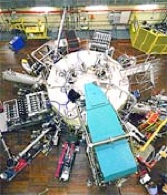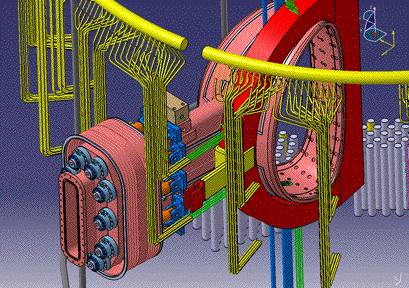




The reactor will be assembled in at the Triniti site in Troitzk, Russia (near Moscow). Manufacturing of Ignitors core is taking place in Italy, where full-sized prototypes of components have been completed. Similarly, additions to the Russian site are already underway in preparation for Ignitor. Construction on the reactor is projected to be complete in 2014, with experimental data collection projected for 2016.
About Ignitor...
Components

Ignitor is a compact fusion reactor with a radius of just 1.32 meters and a height of 3.7 meters (about as tall as a neighborhood street light). Once constructed, the device will weigh 500 tons, approximately as much as 100 adult elephants.
The Ignitor reactor will use a deuterium-tritium (D-T) gas to create a plasma. This is chosen because its high energy yield (17.6 MeV).
To achieve ignition conditions, the Ignitor fusion reactor is comprised of 6 major components:





3D rendering of the toroidal field coils

Weight
500 tons

Height
3.69m
Ignitor Component Statistics
A Diagram of the Ignitor Machine
Central Solenoid: Produces the poloidal (pole to pole) magnetic field for the reactor. Ignitor features a split central solenoid that provides flexibility to produce the expected sequences of plasma equilibrium configurations. The poloidal field is created by superconducting MgB2 coils surrounding the plasma chamber and chosen because of its high transition temperature (becomes superconducting at 39 K).
Plasma Chamber: Contains the fusion reaction. Ignitors plasma chamber is made up of 12, D-shaped sectors welded together to make a donut-like shape called a torus. The chamber is kept at vacuum, and is
Cooling System: Before each plasma pulse, all mechanical components (except the plasma chamber) are cooled to a temperature of 30 K by Helium gas. The time it takes to cool the load assembly after a pulse is approximately 120 hours, or 5 days.


Toroidal Magnetic Fields: In addition to the poloidal field from central solenoid, a toroidal (around the torus) fields is created to induce ignition. The toroidal field is created by 24 copper coils welded together to create the torus of the plasma chamber.
Ion Cyclotron Resonance Heating (ICRH): Though simulations have shown that Ignitor can reach ignition with ohmic heating alone, deviations from optimal conditions (impurities, non 50/50 D-T) lead to a need for further ion acceleration. Six antennae located in the plasma chamber will deliver a frequency in the range of 80 MHz to 120 MHz.
High Speed Pellet Injector: To control the plasma density profile during the initial current rise, a high speed injector will be used to launch pellets from the sides to the center of the plasma column. The pellets will be solid deuterium with a radius of 1.9-4.4 mm and should achieve speeds of 4 km/s.
Ignitor Magnetic Field and Plasma Statistics
encased in Molybdenum tiles, chose because of the materials resistance to high temperatures and erosion by the plasma.
The Ignitor reactor is the first and only experiment proposed and designed to obtain physical conditions that sustain plasma under controllable conditions without the addition of extra heat. This state is known as the point of ignition. Achieving ignition will address the main issues still unresolved in present day research on nuclear fission: demonstrating ignition; studying the physics of achieving ignition; understanding the relevant heating and control issues.